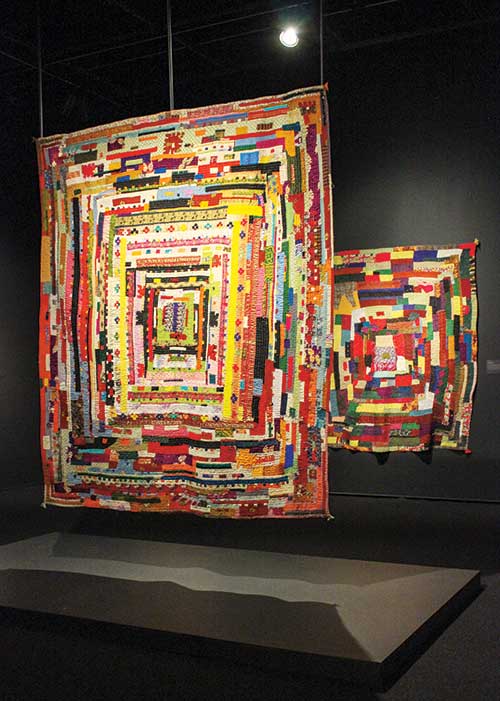
“Soulful Stitching,” on view at the Davis Museum in Wellesley through June 10, highlights an often forgotten area of the African diaspora. “For a lot of people there’s a growing interest in the African diaspora,” says assistant curator Amanda Gilvin. “But in the U.S., there’s more focus on the transatlantic slave trade and less on contemporary immigration.”
On the web
Davis Museum at Wellesley College: www.wellesley.edu/davismuseum
Mount Holyoke College Art Museum: https://artmuseum.mtholyoke.edu
Wellesley Hills Congregational Church: https://hillschurch.org
The Siddis of Karnataka, India are descendants of African immigrants to South Asia and enslaved peoples brought to West India in the 16th century. “Soulful Stitching” presents the historic Kawandi quilts that are still made by contemporary Siddi craftspeople.
Color grabs the viewer first upon entering the exhibit. The Kawandi quilts are made from clothes the family has worn the past year, a living history of the family’s experience. The vibrant reds, yellows and blues of dresses and shirts are stitched together with wide stitches in white thread. Unlike the American quilting tradition, which creates the back, middle and top of each quilt separately and then binds them together, the backing and applique of the Kawandi are stitched together all at once. The backs are traditionally made of new, unworn saris, connecting the asymmetrical African tradition with Indian influence.
“There’s a cultural awareness of being of African descent, and of course, a discrimination in Indian culture,” says Gilvin. Each quilt reflects the artist’s unique vision. Clara Christos retains the memory of each garment in her quilt, and viewers can make out an infant’s shirt here and a pant leg there. The centerpiece of each quilt displays the most aesthetically rich piece of fabric, typically with ornate beading or a textural shine.
Concurrently, the Mount Holyoke College Art Museum displays “Piece Together: The Quilts of Mary Lee Bendolph,” through May 27. Bendolph, an African American artist, is the first of Alabama’s Gee’s Bend Collective to have a solo show. The collective is known for using quilting in civil rights activism. Gilvin says the scholarship on those quilts made possible the scholarship of the Kawandis.
Beyond the cultural power of these artworks, the display of pieces that have historically been deemed “women’s work” is essential to validating crafts as artwork. Gilvin says the exhibition was purposefully displayed the same way as painting and sculpture exhibits to show that the quilts are artistically equal.
Though the pieces in “Soulful Stitching” are not for sale, the Rev. Dr. Pashington Obeng, a professor of Africana Studies at Wellesley, will host a presentation and sale of Siddi quilts on Sunday, April 29 at 11:30 a.m. at Wellesley Hills Congregational Church. The full profits will go back to the Siddi Women’s Quilting Cooperative in Karnataka, the cooperative whose artists are featured in the exhibit.







